
Original Link: https://www.anandtech.com/show/2392
MSI P35 Neo2-FR: Platinum performance for under $100
by Gary Key on December 5, 2007 11:00 PM EST- Posted in
- Motherboards
We have not heard that much from MSI lately. Yes, they always seem to launch product at the same time as ASUS and Gigabyte, but their product launches always seem subdued. Their marketing program does not usually have the all-out blitz we typically see from ASUS or Gigabyte, or their product lineup may lack a killer feature. We know MSI is there - in fact, not a day goes by without us discussing products or technology with them - so what's the problem? It comes down to having a product design or feature that differentiates MSI from the other suppliers. No, we are not talking about roller coaster designed heatpipes; we are talking about product that outperforms the competition at launch or can make a difference in how you use or perceive the value of the product.
We have seen a great deal of improvement in MSI's motherboard products over the course of the last year. Their layouts have improved and in fact, we absolutely love the layout on the new K9A2 Platinum board that uses AMD's new 790FX chipset. MSI also offers the Creative Lab's X-Fi audio codecs on their high-end boards as a nod to the gaming community. In addition to unique layouts or features, their overall product quality and commitment to performance has been steadily improving. Our problem with MSI the past few product launches has not centered on them being late to market or not having compelling product alternatives. It has come down to basic performance, compatibility, and BIOS features that leave a lot to be desired when comparing them to the likes of ASUS or Gigabyte. We witnessed this with the P35 launch last spring and again with the 790FX a couple of weeks ago. Their boards are solid and perform well at launch; only the BIOS releases have been weak. The difference we are seeing now is that MSI is quickly resolving problems, and they continue to provide support and updates over the lifespan of the product.
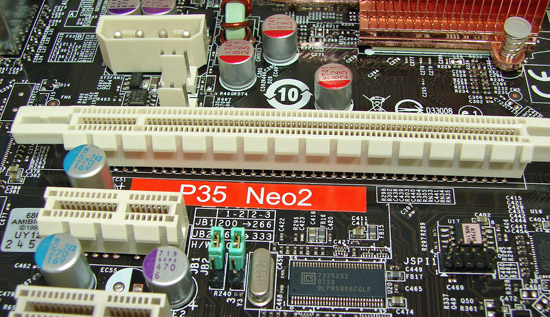
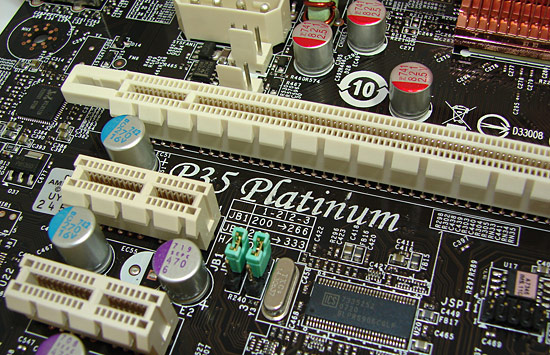
Identical or Fraternal Twins?
The other difference is that MSI is starting to offer a compelling value in certain market segments. One such market segment is the quickly growing budget performance sector, which is now moving to Intel's P35 chipset. The initial launch of the P35 chipset featured boards in the $200 and up price grouping from ASUS, Gigabyte, and MSI. MSI's offering, the P35 Platinum, was at the low end of this sector but did not offer a very good price to performance ratio when compared to the other boards. This changed greatly a few weeks after its release with the P3 performance-oriented BIOS. However, there was an eerie silence at the time as abit had just introduced the similarly priced and very impressive IP35-Pro to a thunderous roar from the user community.
With the introduction of the X38 chipset and the widespread adoption of P35 across a variety of products, we are now seeing incredible competition in the budget to midrange markets. As competition has increased, prices have decreased and the selection of performance-oriented motherboards for under a $130 is incredible. We say this considering the typical prices that usually accompany Intel chipsets. What is even more amazing is the level of performance and features that a user can purchase for under $100 now. We are not talking about the P965 or 945P based boards, but boards designed around the P35 chipset.
MSI offers a base P35 board for around $72, but that board like other budget designs is suited for SOHO users. What excites us in the under $100 performance market are boards like the abit IP35-E and Gigabyte GA-P35-DS3L. Recognizing this trend, MSI developed the Neo2 series. In actuality, they did not have to do too much development; the Neo2-FR/FIR is just a rebadged P35 Platinum with a couple of features missing. MSI is not really hiding this fact; the user can easily remove the Neo2 label to see the Platinum silk screen. The features missing are not extensive either; the FR board drops FireWire and an S/PDIF Optical out port while the FIR is only missing the Optical out port.
Fortunately, for us the performance remains the same, as does the support, features, and quality. The only difference is the almost $40 reduction in price, something we can all use. Let's look at the MSI Neo2-FR feature set and performance results. Our findings might just make you sit up and take notice of MSI again.
MSI P35 Neo2-FR: Board Layout and Features
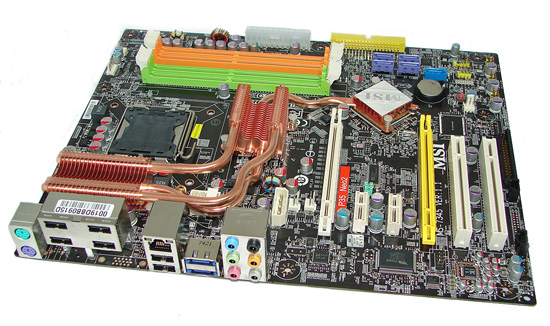 |
MSI devised a new heatpipe system for this series of boards to replace the rollercoaster version on the Platinum boards. Frankly, we certainly think it looks better and cooling performance remains roughly equal. The color scheme is awkward, with various neon colors sitting atop an otherwise elegant black PCB, but appearance probably isn't at the top of the list of important considerations when discussing sub-$100 motherboards. The board was a snap to install in our Antec P180 and Cooler Master 830 cases with most connections easily reached. The Neo2-FR board features a high quality four-phase voltage regulator system that provided excellent stability throughout testing. The board also utilizes Conductive Polymer Aluminum Solid Capacitors.
The MSI P35 Neo2-FR comes with six fan headers (1 x 4-pin, 5 x 3-pin) that provide an excellent balance of cooling options. However, there are limited control options in both the BIOS and MSI's Dual Core Center program. The BIOS controls are limited to percentage based fan speed controls for the CPU and Northbridge fan headers. The Dual Core Center allows changes that are more extensive but are still percentage based. The DCC also allows fan speed monitoring for two system fan headers. This is one of the biggest weaknesses of the board. We wish all manufacturers would design a decent set of applications that match or exceed abit's µGuru technology. Otherwise, we are going to continue to deduct points from manufacturers in this area.
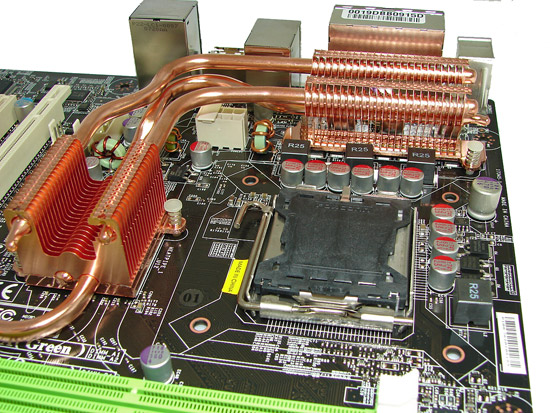 |
Around the CPU socket, we find an ample amount of room for the majority of cooling solutions. We utilized the stock heatsink/fan in our base testing and it worked fine. We also installed several aftermarket Socket-775 cooling solutions such as the Tuniq 120 and Thermalright Ultra-120 eXtreme during our overclocking tests without a problem. However, based upon our initial overclocking tests, if you use a vertical mounted fan with an air cooler (i.e. Tuniq 120) or water-cooling then additional air-cooling will be required on the MCH and PWM areas. In other words, the heatpipe system requires additional fan cooling or the use of a downward blowing CPU HSF fan.
The 8-pin ATX power connector is located in between the heatpipe system. It was easy to our install our power cable but difficult to remove. MSI does include an adapter but we preferred not to use it. We removed the heatpipe system easily to test water-cooling on the MCH/ICH chipsets.
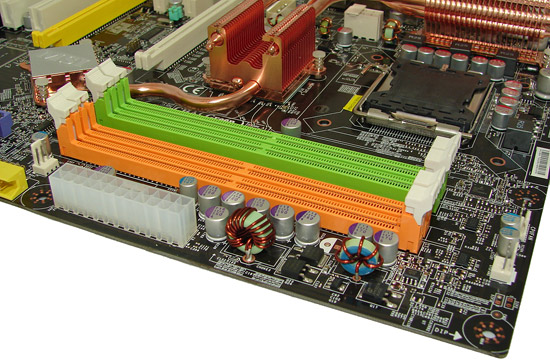
The DIMM module slots' color coordination is not correct for dual channel setup based upon the premise of installing DIMMs in the same colored slots for dual-channel operation. MSI continues to use this coordination scheme, for reasons unknown. The green slots are Channel A and the orange slots are Channel B, and dual-channel requires installing one or two DIMMs into each channel. Installing memory modules with a full size video card placed in the first PCI Express x16 slot was not a problem. The 24-pin ATX power connector is located on the edge of the board along with the number three system fan header.
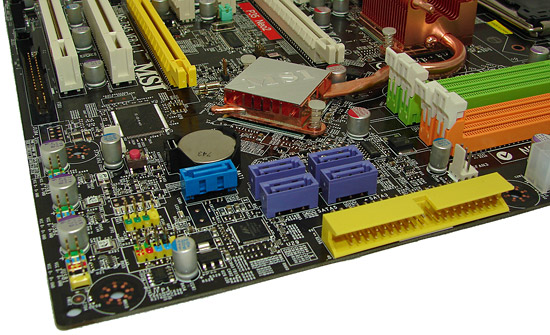
We found the positioning of the four purple ICH9R SATA ports to be excellent when utilizing the expansion slots, as they are out of the way of longer cards. However, a full-size card located in the second PCI Express x16 (physical) slot will partially block the light-blue SATA slot. The passively cooled ICH9R chipset remained cool to the touch throughout testing. The IDE connector is located below the SATA ports.
MSI added a red clear CMOS button on the board. Of interest, MSI has a series of LED lights in the same location that take the place of the typical POST Code Debug display. The user can decipher the error sequences displayed by the led panel by looking in the manual, though with four lights they are limited to sixteen codes. Personally, we prefer the standard debug displays, but for the price we can't really complain.
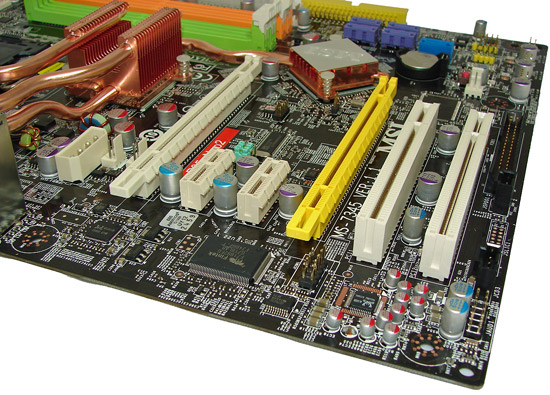
The board comes with two physical PCI Express x16 connectors (1 x16, 1 x4 electrical), two PCI Express x1 connectors, and two PCI 2.3 connectors. Dual-slot graphics cards will block the first PCI Express and PCI slots. A 4-pin 12V Molex connector is to the left of the first PCI Express x16 slot for CrossFire operation; MSI also recommends using the additional power connection if all of the expansion slots are populated. MSI includes a set of jumpers that allows the user to set the FSB rates at 200, 266, and 333.

The rear panel contains the standard PS/2 mouse and keyboard ports. The panel also includes an RJ-45 LAN port with activity indicator lights, six USB ports, and two eSATA ports. The audio panel consists of six ports that support 2, 4, 6, and 8-channel audio connections for the Realtek ALC888T HD codec.
MSI P35 Neo2-FR Specifications
| MSI P35 Neo2-FR | |
| Market Segment | Budget Performance - $88.99 after Rebate |
| CPU Interface | Socket T (Socket 775) |
| CPU Support | LGA775-based Pentium 4, Celeron D, Pentium D, Pentium EE, Core 2 Duo, Core 2 Extreme, Core 2 Quad |
| Chipset | Intel P35 MCH and Intel ICH9R |
| Bus Speeds | Auto, 133 ~ 600 in 1MHz increments |
| DDR2 Memory Speed | Auto,1:1, 1:1.2, 1:2, 1:1.25, 1:1.6, 1:1.5 |
| PCIe Speeds | Auto, 100MHz~200MHz in 1MHz Increments |
| CPU Voltage | Auto, Base CPU - +0.7875V in 0.0125V increments |
| SB Voltage | 1.05V, 1.15V |
| SB I/O Voltage | 1.50V ~1.80V in .05V increments |
| CPU Clock Multiplier | Auto, 6x-50x in 1X increments if CPU is unlocked, downwards unlocked, Core 2 Duo/Quad/Extreme |
| DDR2 DRAM Voltage | Auto, 1.80V ~ 2.60V in .05V or .10V increments |
| DRAM Timing Control | Enabled SPD, Disabled, 9 DRAM Timing Options |
| NB Voltage | Auto, 1.250V ~ 1.650V in .025V increments |
| VTT Voltage | Auto, 1.175V ~ 1.550V in .025V increments |
| Memory Slots | Four 240-pin DDR2
DIMM Slots Dual-Channel Configuration Regular Unbuffered Memory to 8GB Total |
| Expansion Slots | 2 - PCIe X16
(1x16, 1x4 electrical for CrossFire or Multi-GPU) 2 - PCIe x1 2 - PCI Slot 2.2 |
| Onboard SATA/RAID | 4 SATA 3Gbps Ports
- ICH9R (RAID 0,1, 10, 5) 2 eSATA 3Gbps Port - ICH9R 1 SATA 3Gbps Port - Marvell 88SE6111 |
| Onboard IDE | 1 ATA133/100/66 Port (2 drives) - Marvell 88SE6111 |
| Onboard USB 2.0/IEEE-1394 | 12 USB 2.0 Ports -
6 I/O Panel - 6 via Headers 2 Firewire 400 Ports by VIA VT6308 - Requires FIR board |
| Onboard LAN | Realtek RTL8111B PCIe Gigabit Ethernet controller |
| Onboard Audio | Realtek ALC888T - 8-channel HD audio codec |
| Power Connectors | ATX 24-pin, 8-pin EATX 12V, 4-pin Molex connector |
| I/O Panel | 1 x PS/2
Keyboard 1 x PS/2 Mouse 2 x eSATA 1 x IEEE 1394a - Requires FIR board 1 x Audio Panel 1 x RJ45 6x USB 2.0/1.1 |
| BIOS Revision | v1.6 |
| Board Revision | v1.0 |
MSI designed the P35 Neo2-FR for the enthusiast user on a budget. The BIOS options available are extensive for a board in this price category and place an emphasis on overclocking. MSI provides the standard laundry list of board options such as the Marvell 88SE6111 for eSATA and IDE support, optional IEEE 1394 support from VIA on the FIR board, decent onboard audio support from the Realtek ALC888T, 12 USB ports, Intel Matrix RAID, and Gigabit LAN support from the ubiquitous Realtek RTL8111B chipset.
The board offers a very good mix of expansion slots. Utilizing a CrossFire setup will create the physical loss of a PCI and PCI Express slot with dual-slot cards, but we still recommend utilizing the 975X or X38 chipsets for CrossFire operation. We ran a few early tests with a QX9650 Yorkfield CPU and the board operated fine. MSI has not finished fully tuning the BIOS for Yorkfield, but they should in the near future. Speaking of the BIOS, its design has not changed from the P35 Platinum, nor have the options - something we dearly wish that MSI would address in their next product release. It's not that bad, but the layout could be better and additional auto settings would be welcome in the memory timing section.
MSI includes several Windows utility programs, with Dual Core Center and Live Update being the two major applications. Just like the majority of utility programs from most manufacturers, they are somewhat interesting to look at for a few minutes, but we quickly removed them from our system to utilize third party programs for tuning and measurements. We also had a problem updating our BIOS from 1.3 to 1.6 with the Live Update program. The BIOS update completed normally and our system rebooted as planned. However, it would not POST correctly after several on/off episodes. Thinking the board might be dead, we decided to try a couple of options before contacting MSI. We switched out our processor to the E2160 and the board booted fine. We set the BIOS to defaults, shutdown, inserted the Q6600, and it started right back up.
Attempting to replicate the problem, we tried the Live Update procedure on an MSI P35 Platinum board when upgrading from the engineering BIOS to an early public release. We did not have a problem there, but we did when upgrading to the latest BIOS. This time, we set the FSB jumpers on the board to 200 and it went straight through the POST routine. The only thing we can think of is that the FSB rates are not being set correctly after the flash routine. However, we did not have a single problem flashing with the DOS utility.
Test Setup
| MSI
P35 Neo2-FR Overclocking/Benchmark Testbed |
|
| Processor | Intel Core 2 Quad Q6600 (Quad-core, 2.4GHz, 2x4MB Cache, 9x Multiplier, 1066FSB) |
| CPU Voltage | 1.200V ~ 1.450V |
| Cooling | Thermalright 120 Extreme |
| Power Supply | OCZ 1000W |
| Memory | Corsair Twin2x2048-10000C5DF (2GB/4GB) OCZ PC2-6400 Reaper X (4GB/8GB) |
| Memory Settings | 4-4-4-12 (DDR2-1066) - Corsair 4-4-3-12 (DDR2-800) - OCZ |
| Video Cards | MSI HD X2900 XT 512MB |
| Video Drivers | ATI Catalyst 7.10 |
| Hard Drive | Western Digital 7200RPM 750GB SATA 3/Gbps 16MB Buffer |
| Optical Drives | Plextor PX-B900A, Toshiba SD-H802A |
| Case | Cooler Master Stacker 830 Evo |
| BIOS | v1.6 |
| Operating System | Windows Vista Home Premium 32-bit |
| . | |
We maintained the same test conditions, as much as possible, over the platforms tested. The game tests are at settings of 1280x1024 HQ to ensure our MSI HD 2900XT is not the bottleneck during testing. We color-code all scores for easier identification of results. We selected the Intel Core 2 Quad Q6600 as our processor of choice since it represents one of the better price to performance values in the midrange processor market and is the CPU we will concentrate on in future reviews.
We are utilizing Microsoft Vista Home Premium 32-bit as our operating system along with a 4GB memory configuration. Even though Vista 32-bit cannot take advantage of the entire 4GB of memory address space, we find the additional 1.278GB of memory provides improved performance during multitasking events and gaming. We do not recommend anything less than 2GB for Vista Home Premium. We will be moving back to Vista 64-bit shortly along with a new test suite for 2008. We will also conduct our overclocking tests under Vista 64-bit for this article to show the 2x2GB and 4x2GB results properly.
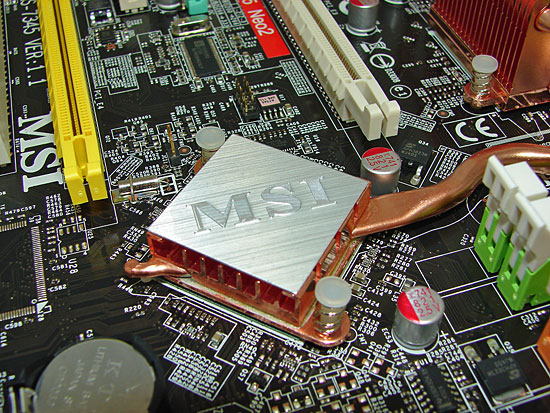
We utilize new drive images on each board in order to minimize any potential driver conflicts. The 3DMark tests utilize the standard benchmark resolution for each program. We run each benchmark five times, throw out the two low and high scores, and report the remaining score. All results at stock speeds for this article are with memory timings of 5-4-4-12 (DDR2-1066) for the MSI Neo2-FR and 4-4-4-12 (DDR2-1066) for the other boards. Where possible, memory sub-timings are set the same to ensure consistency between the boards.
To be honest, except for the memory and overclocking tests, this board scores the same as any other P35 based board we have tested. Any differences in our benchmark results are minute at best. Therefore, we base our review primarily on cost, support, service, and features, with performance being a secondary consideration. It is in these areas where the MSI P35 Neo2-FR has a few advantages over other boards in its price range.
Memory Testing and Overclocking
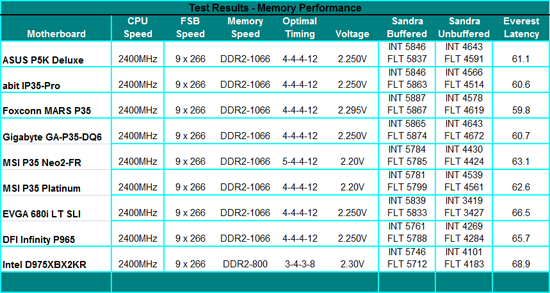 |
The MSI P35 Neo2-FR latency and unbuffered scores trail other P35 boards slightly. This is due in part to running CAS 5 instead of CAS 4 at DDR2-1066 and MSI setting tRD to 5 at this level for absolute stability. Our board would run 4-4-4-12 timings but required 2.4V to pass all benchmarks. That voltage level is unacceptable to us. However, we will see overall performance is still extremely competitive with the other P35 boards.
E2160 9x390
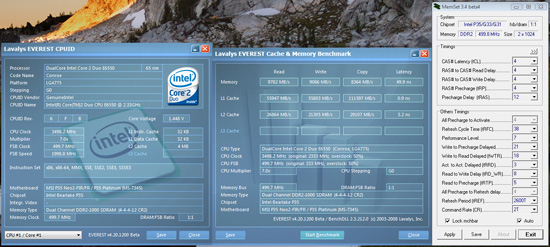 |
Our best performance results with this processor were at a final FSB setting of 390 with a 2GB memory configuration at the 4:5 ratio and 4-4-4-12 timings. This results in the board setting performance level (tRD) to 5 but required 2.2V for memory. MCH voltage is set to 1.40V and CPU voltage is at 1.4750V, with Vdrop/Vdroop realizing a final 1.44V during normal operation. The highest FSB we have been able to attain with this CPU is 410 on the DFI P35 board.
E6550 7x500
 |
We were able to reach a final FSB setting of 500 with our retail E6550. Our 2GB memory configuration used a 1:1 ratio with 4-4-4-12 timings. This results in the board setting performance level (tRD) to 7. MCH voltage is set to 1.45V, memory voltage to 2.20V, and CPU voltage is set to 1.4750V with Vdrop/Vdroop realizing a final 1.44V during normal operation. The highest FSB we have been able to attain with this CPU is 510 on the DFI P35 board. Our handpicked E6550 will reach 7x535 on this board while attaining 7x550 on the abit IP35-Pro and MSI Platinum boards.
Q6600
9x415
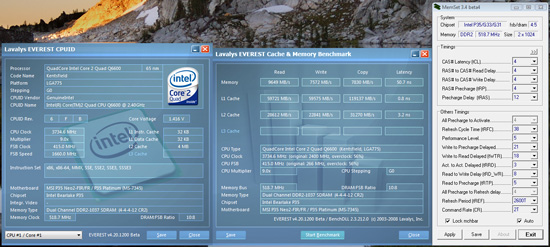 |
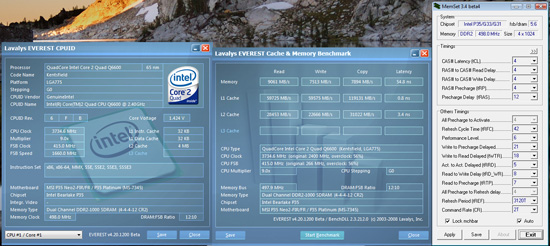 |
Our max CPU results on air-cooling resulted in a final 9x415 setting. Our 2GB memory configuration uses the 4:5 ratio with 4-4-4-12 timings and performance level (tRD) at 5. The 4GB memory configuration uses a 5:6 ratio, memory timings at 4-4-4-12, and tRD at 6. This results in lower performance of 1%-2% during application testing in a variety of benchmarks. We did complete our benchmark test suite with 4GB at the 4:5 ratio but this required MCH voltage at 1.6V and memory at 2.4V, neither of which is acceptable for air-cooling and 24/7 usage. The results for both memory configurations use MCH voltage at 1.450V, memory voltage at 2.20V, and CPU voltage at 1.4675V with Vdrop/Vdroop realizing a final 1.41V during normal operation. We also set VTT to 1.30V and SB I/O to 1.7V. It seemed anytime we clocked this board up, we had to set SB I/O to 1.7V or 1.8V with quad-core CPUs.
Q6600
8x465
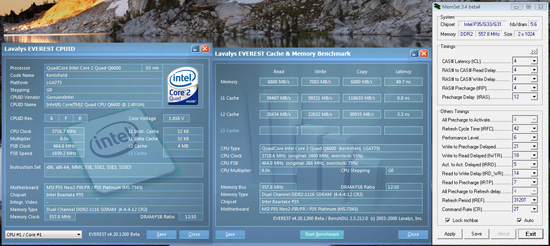 |
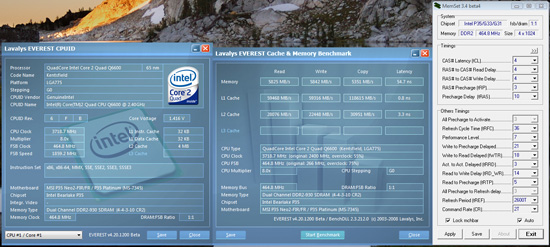 |
We reach a maximum FSB of 465 with quad-core on air-cooling using an 8X multiplier. Our 2GB memory configuration uses the 5:6 ratio with 4-4-4-12 timings; performance level (tRD) is set to 6 for a final speed of DDR2-1116. The 4GB memory configuration is at a 1:1 ratio, memory timings at 4-4-3-10, and tRD at 7. This again results in lower performance of around 1%-3% during application in a variety of benchmarks. We were able to run the 4:5 ratio with 2GB of memory installed for a final DDR2-1162 setting with 5-5-4-15 timings but at 2.4V. Our 4GB memory configuration was not stable at 4:5 or 5:6 regardless of voltages and reasonable timings, but we a bigger problem as well.
The problem is that once we started to raise the FSB over 445 with the Q6600 or QX6850 processors, the board automatically (drastically) reduced chipset timings and memory sub-timings. We have noticed this occurring on a couple of other budget level P35 boards and figure the manufacturer is trying to save the board - or maybe reach artificially high FSB rates with quad-core CPUs. We feel that the FSB rates are deceiving, as most boards have to compensate for higher FSB rates with increased strap settings and looser chipset/memory timings. When comparing application results during overclocking testing with the 8x465 and 9x415 results, we noticed a 3%-6% difference in memory sensitive benchmarks after compensating for the slightly higher CPU speeds in the 9x415 setting. Our advice on this board is to run lower FSB rates at higher multipliers with quad-core in order to maximize performance.
The final settings for each memory configuration is MCH voltage at 1.55V, memory voltage at 2.20V, and CPU voltage at 1.4675V with Vdrop/Vdroop realizing a final 1.41V during normal operation. We set VTT to 1.30V and SB I/O to 1.8V.
Q6600
9x400 2GB Module Testing
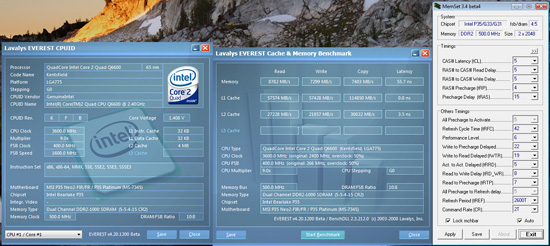 |
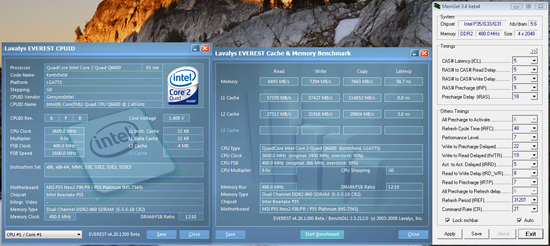 |
OCZ was kind enough to send us some of their new ReaperX 2GB modules for 4GB and 8GB testing. We have reached DDR2-1100 with 8GB on the DFI P35 board at 5-5-4-15 timings. However, in our initial testing of several boards, we have noticed that BIOS tuning for 2GB modules is not up to par with 1GB modules. We expect this to improve over time. We can say that our Neo2-FR BIOS could use additional tuning, but it still performs extremely well and stability was never a problem once we dialed in the memory settings.
We utilize a 9x400 setting with our Q6600 set to 1.4375V, MCH at 1.450V, and VTT at 1.30V. Memory voltage was set to 2.1V as recommended. Our 4GB memory configuration uses a 4:5 ratio at 5-5-4-15 timings with performance level (tRD) at 6, which results in a DDR2-1000 memory speed. The 8GB memory configuration uses a 5:6 ratio, memory timings at 5-5-5-18, and tRD at 7. This results in fractionally lower performance (~1%) during application testing with a variety of benchmarks.
The overclocking capability of this motherboard is very good, if not excellent for the price. The board's stability will start to trail off when you are near its limits so there is feedback from the board before you go over the edge. The board does not overclock quite as well as the DFI P35 TR or Gigabyte GA-P35-DQ6 boards, but at 39% of the cost, we think it more than fits the bill as a performance oriented budget board. However, we hope MSI can fine tune 2GB module performance further and work on 4:5 memory ratio compatibility with 4x1GB configurations. If we could change one item with the overclocking capabilities, it would be allowing 4:5 ratio capabilities above DDR2-1000 with 4x1GB installations. Of note, the BIOS recovery system worked extremely well when we exceeded the limits of the board. However, it was sometimes necessary to perform a full shutdown and startup procedure when resetting the board.
Synthetic Graphics Performance
The 3DMark series of benchmarks developed and provided by Futuremark are among the most widely used tools for benchmark reporting and comparisons. Although the benchmarks are very useful for providing apple to apple comparisons across a broad array of GPU and CPU configurations they are not a substitute for actual application and gaming benchmarks.
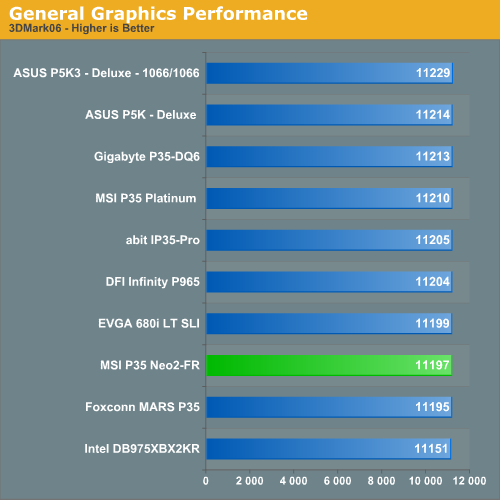
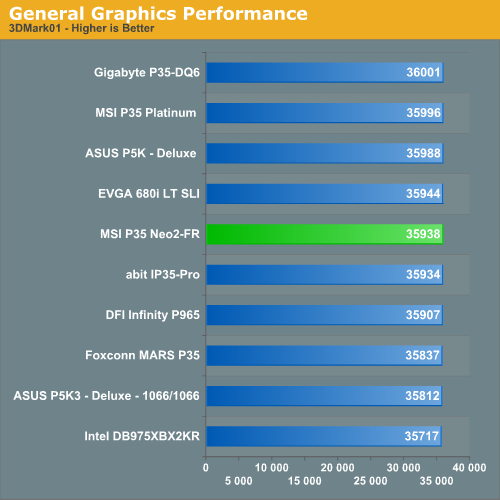
In our 3DMark06 test, all of the boards are within 1% of each other. When looking at the individual tests, the MSI board scores well in the CPU and SM2.0 sections and fourth from last in the SM3.0 tests.
In the more memory and CPU throughput sensitive 3DMark01 benchmark, we again see the spread between boards is less than 1%. The Neo2-FR board scores in the middle of the pack but is only 63 points from the lead even with a slight handicap in memory settings.
General System Performance
The PCMark05 benchmark developed and provided by Futuremark measures overall system performance for the typical home computing user. This tool provides both system and component level benchmarking results utilizing subsets of real world applications or programs. This benchmark is still useful for providing comparative results, but PCMark Vantage will replace it in our next article.
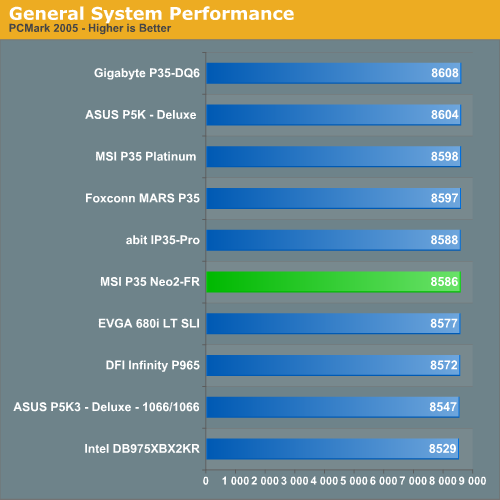
Once again, all of the boards are within 1% of each other with the Neo2-FR board finishing in the middle of the test group. There's nothing interesting to report here, so let's move on.
Media Performance
We will take a brief look at general media performance with our test suite that includes Adobe Photoshop CS2 and Adobe Photoshop Elements 5.0. We utilize the PC WorldBench 6.0 Test for measuring platform performance in Adobe's Photoshop CS2. The benchmark applies an extensive number of filters to the test image and heavily stresses the CPU and storage systems. The scores reported include the full conversion process and are in seconds, with lower numbers indicating better performance.
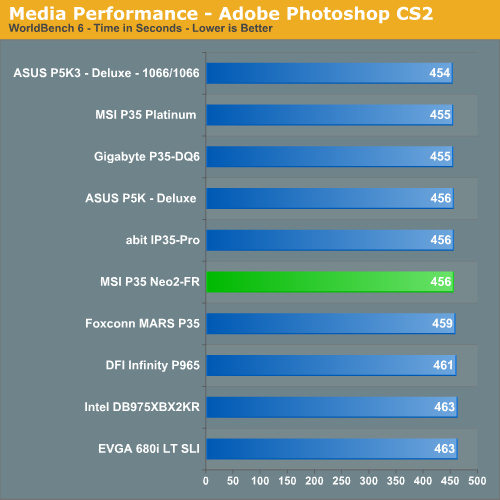
This test requires a balance between CPU speed and a fast storage subsystem. The Neo2-FR board scores within two seconds of the top board.
Our next test is one recommended by Intel, but the test itself appears to be fair and results are very repeatable. This test simply measures the amount of time required to fix and optimize 103 different photos weighing in at 63MB. We report results in seconds, with lower times indicating better performance
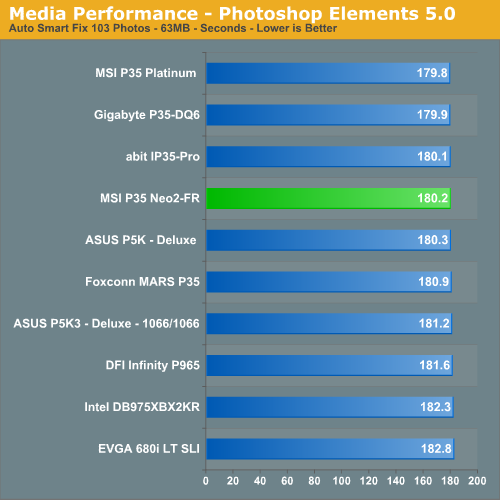
The Neo2-FR board scores well in this CPU intensive test and is only 0.4 seconds slower than its big bother. With the memory timings set identically, the board is just as fast as the Platinum version.
Media Encoding Performance
We are utilizing Nero Recode 2 and Sony Vegas 7.0e for our video encoding tests. The scores listed include the full encoding process represented in seconds, with lower numbers indicating better performance.
Our first series of tests is quite easy - we take our original Office Space DVD and use AnyDVD to rip the full DVD to the hard drive without compression, thus providing an almost exact duplicate of the DVD. We then fire up Nero Recode 2, select our Office Space copy on the hard drive, and perform a shrink operation to allow the entire movie along with extras to fit on a single 4.5GB DVD disc. We leave all options on their defaults except we uncheck the advanced analysis option.
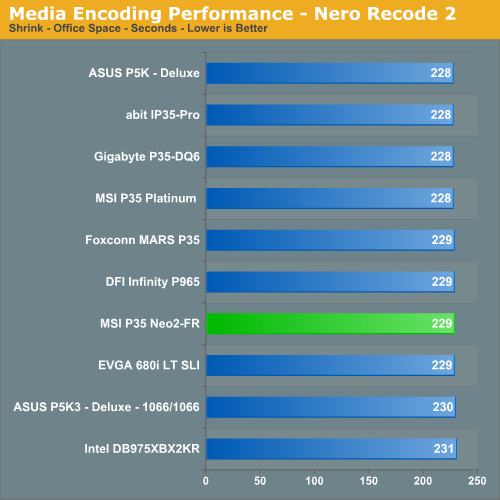
We find in this CPU and disk intensive test that all of the boards are within 1% of each other with the Neo2-FR board finishing one second slower than the fastest boards. Over the course of a year, that difference might add up to an extra five minutes of your life back. However, if you are burning that many DVDs, you are probably in need of much more than five minutes of saved time.
Our Sony Vegas 7.0e test converts several of our summer vacation files into a plasma-screen-pleasing 1080/24P format with a 5.1 audio stream. We ensure our quality settings are set to their highest levels and then let the horses loose.
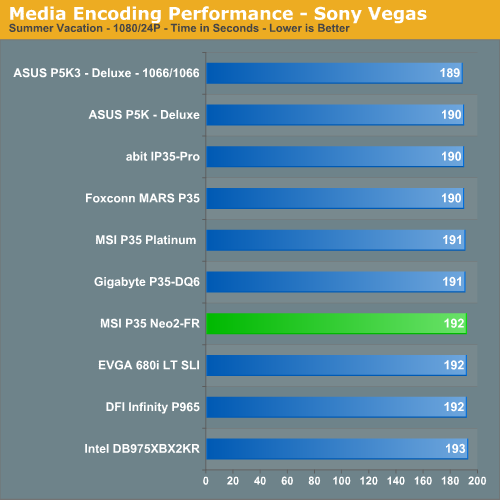
In a test that really stresses the CPU and memory subsystem, we see the Neo2-FR board trailing the other P35 boards. This result once again confirms the slower memory timings make a difference, however slight - 1.5% in this case.
Audio Encoding Performance
We will utilize iTunes 7.4 for our audio encoding test, as it is one of the most utilized audio applications available due to the immense popularity of the iPod. As in previous articles, we are using an INXS Greatest Hits CD for testing, which contains 16 tracks totaling 606MB of songs. We use iTunes to convert our WAV files into ACC or MP3 compatible formats. We utilize 320kbps or 256kbps and variable bit rate options for both tests.
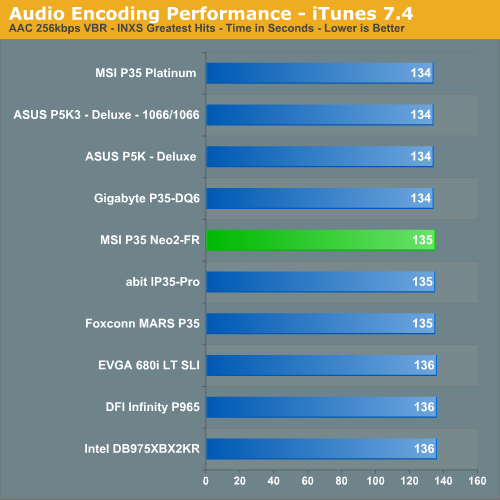
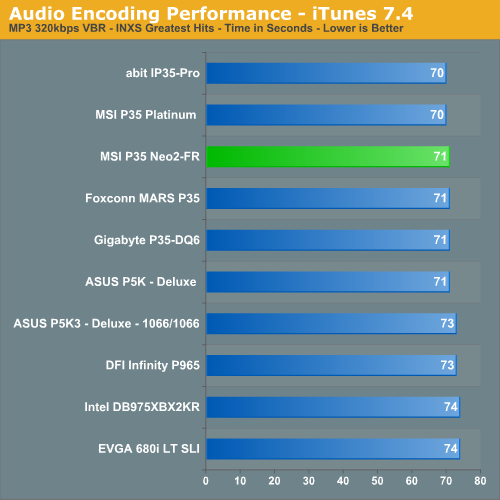
We usually see iTunes favoring a system with excellent CPU throughput and these tests indicate the Neo2-FR board is up to speed in this area. However, if it is not apparent by now, all of the P35 boards score within 2% of each other and it is difficult to discern any differences during actual usage of the application.
File Compression Performance
In order to save space on our hard drives and provide another CPU crunching utility, we utilize WinRAR 3.70 to perform compression tests. WinRAR fully supports multithreaded operations for users with dual core or multi-processor systems. Our test folder contains 444 files, 10 subfolders, and 602MB worth of data. We utilize default settings in WinRAR and defragment our hard drive before each test.
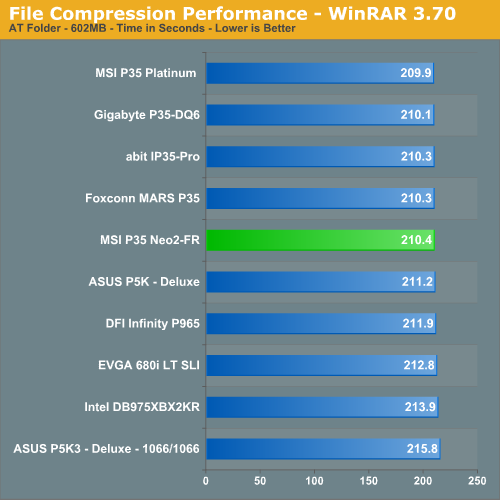
The nature of file compression is such that memory is accessed almost constantly in a very random fashion, so page misses requiring additional time as memory banks are swapped is common. Even with a slight disadvantage in memory latencies, we notice the MSI board still has very good CPU/Memory throughput. It finishes 0.5 seconds behind the Platinum board, which leads the P35 pack.
Rendering Performance
For 3D modeling and rendering, we are using the CINEBENCH R10 benchmark. CINEBENCH 10 features two different benchmarks with one test utilizing a single core and the second test highlighting the power of multiple cores in rendering the benchmark image. We utilize the standard multi-core benchmark and default settings.
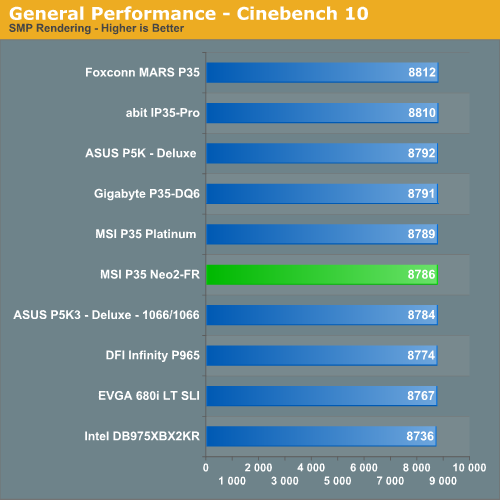
The Neo2-FR board performs well in this CPU intensive test and finishes right behind the Platinum board.
Gaming Performance
As usual, we test gaming performance with a variety of (nearly - we'll be updating soon!) current games. We run our benchmarks at 1280x1024 with high quality settings.
Battlefield 2
This benchmark utilized DICE's built-in demo playback functionality with additional capture capabilities designed in-house. During the benchmark, the camera switches between players and vehicles in order to capture the most action possible. There is a significant amount of smoke, explosions, and vehicle usage; the benchmark is sensitive to GPU and to a lesser extent CPU selections.
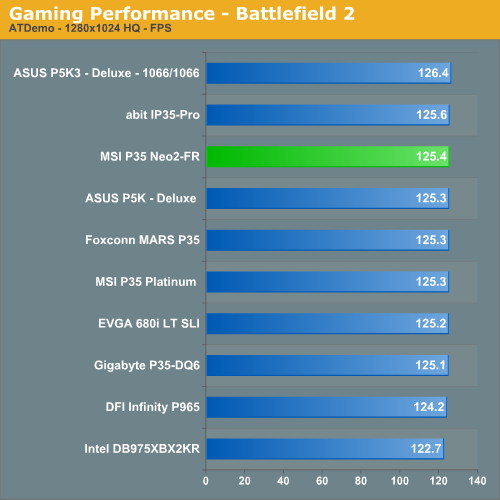
Company of Heroes
Company of Heroes arrived last year and remains one of the best samples of the genre. The game is extremely GPU intensive and requires a hefty CPU as well. The game contains a built-in performance test that utilizes the game engine to generate several different action scenes. We find the performance test gives a good indication of how well your system will perform throughout the game. We use the DX9 codepath, as DX10 performance suffers even on the fastest current systems.
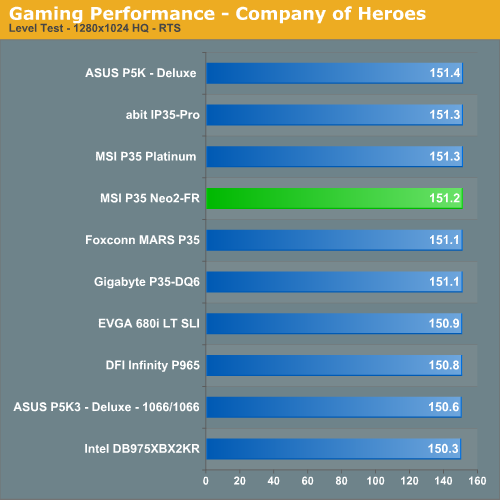
Prey
Prey offers some superb action sequences, unique weapons and characters, and is a visually stunning game at times. It still requires a very good GPU to run it with all of the eye candy turned on. We set all graphic settings to their maximum except for AA/AF and utilize a custom timedemo that takes place during one of the more action-oriented sequences.
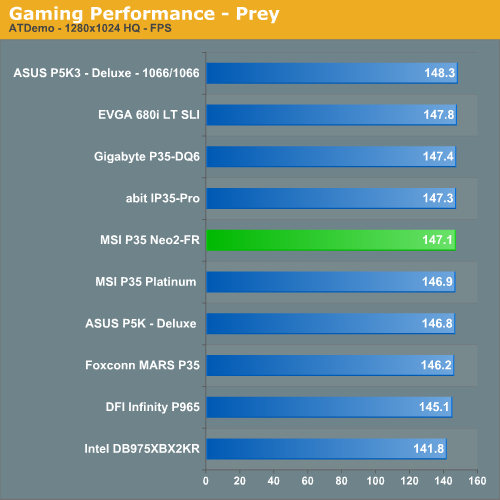
Supreme Commander
Supreme Commander is one of the favorite real time strategy games around the office and requires both a very good CPU and GPU when playing the game at anything above 1024x768 with decent settings. We utilize the game's built-in benchmark for our results.
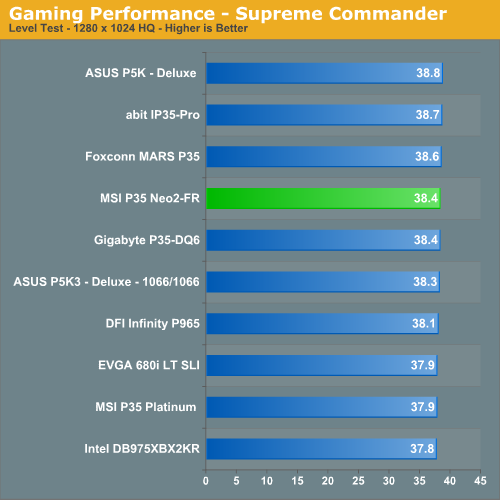
Gaming Summary
The Neo2-FR board's overall performance is very consistent throughout our game testing. During game play testing with Crysis, UT3, and Quake Wars, the board performed superbly. We would not hesitate to recommend this board as a stable and inexpensive choice for a gaming platform.
Disk Controller Performance
We have utilized the Intel iPEAK test for the past few years to measure "pure" hard disk or controller performance on Windows XP. Unfortunately, iPEAK is not compatible with Vista so we will utilize two sections of the HDD test suite within PCMark05 for comparative hard disk or controller scores until our Vista hard disk test suite is ready.
This particular test suite provides a mixture of actual application results and specific read/write percentages within these programs. The program utilizes the RankDisk application within the Intel iPEAK SPT suite of tools to record a trace of disk activity during usage of real world applications. PCMark05 replays these traces to generate performance measurements based upon the actual disk operations within each application. The HDD test suite contains 53% read and 47% write operations with each trace section utilizing varied amounts of read or write operations. Additional information about the test suite is available in PDF format.
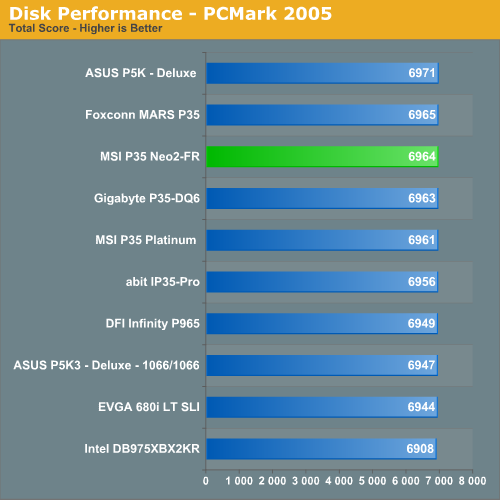
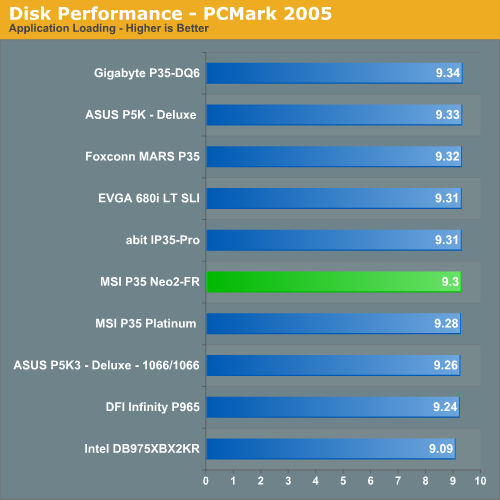

The performance pattern in these tests indicates what we witnessed in actual application testing. In tests that are heavily dependent on the storage system, the Neo2-FR board performs well and generates consistent results in each test. However, the board finishes near the top as it excels in the Write and Window's XP startup tests when compared to the boards.
Ethernet Performance
LAN performance is also an area worth looking at, as these boards might be serving up media to the rest of the house. All of these boards utilize PCI or PCI Express based controllers with the only difference being the supplier of the core logic.
The Windows 2000 Driver Development Kit (DDK) includes a useful LAN testing utility called NTttcp. We use the NTttcp tool to test Ethernet throughput and the CPU utilization of the various Ethernet Controllers. We set up one machine as the server - in this test, an Intel system with an Intel CSA Gigabit LAN connection. Intel CSA has a reputation for providing fast throughput and is a logical choice for our Gigabit LAN server.
On the server side, we use the following Command Line as suggested by the VIA whitepaper on LAN testing:
Ntttcpr -m
4,0,‹server IP› -a 4 -l 256000 -n 30000On the client side (the motherboard under test), we use the following Command Line:
Ntttcps -m
4,0,‹client IP› -a 4 -l 256000 -n 30000At the conclusion of the test, we capture the throughput and CPU utilization figures from the client screen.
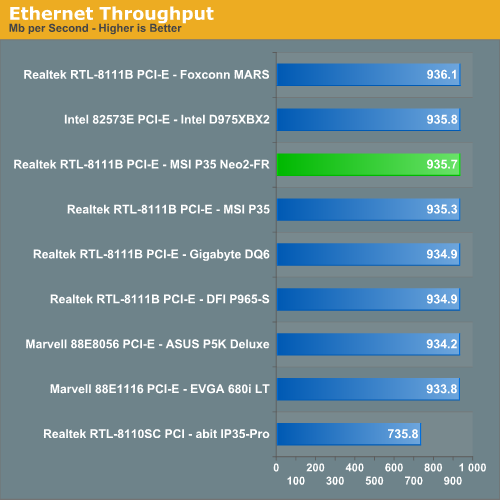
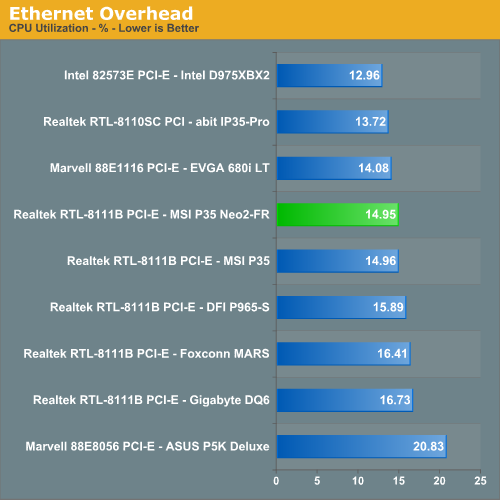
The throughput performance and CPU utilization numbers of the onboard Realtek RTL-8111B are in alignment with the other boards utilizing this chipset. However, any performance differences are slight and not noticeable under normal operating circumstances.
Final Thoughts
MSI surprised us with the overall performance of the P35 Neo2-FR motherboard. We figured they would neuter the performance of the board so as not to cannibalize sales of the P35 Platinum series. Turns out, we were incorrect. Sure, the Platinum board has FireWire, S/PDIF Optical out, and a conversation generating roller coaster cooling system, but it also costs about $40 more. The performance between the two boards is almost identical making this purchasing decision easy in our opinion unless you need FireWire capabilities. If so, MSI offers the Neo2-FIR for about $10 more.
Our expectations of products in the sub $100 market for Intel have changed considerably over the past couple of months. We are testing the abit IP35-V, DFI Blood IronP35-T2RL, and Gigabyte GA-P35-DS3L currently and have been especially impressed with the level of performance you can get at the $100 level. In fact, we would venture to say at this point, that the price to performance ratios of these boards could very well make their more expensive relatives obsolete, provided the feature lists match your needs.
We think MSI's decision to utilize the P35 Platinum board design as the basis for the Neo2 series is an excellent idea from both a manufacturing and marketing viewpoint. In our opinion, MSI actually improved the product family by changing the heatpipe system from the Platinum version. Gone is the roller coaster adventure series and in its place MSI installed a standard if visually conservative heatpipe system that not only has better aesthetics, but also cools just as well in our test conditions.
We do miss the FireWire support, but it is available on the FIR series; the problem with that is that we only found the FIR at a couple of resellers. Overall, this board performs very well but it does have a few quirks (Ed: what board doesn't?) when overclocking and utilizing the 4:5 memory ratios with 4GB installed. We were not always pleased with the board's two-step recovery from failed BIOS settings and the included utilities are just not up to par with abit's µGuru technology. However, MSI did a wonderful job with this board considering the cost targets required to compete in this market sector.
 |
Overall, this board certainly has more positives than negatives. Its negatives are generally minor and BIOS tuning will likely solve the few performance problems we encountered during overclocking. To be honest, it's the product quality, MSI's support, and price to performance advantages this board offers that really win us over. If MSI offered better utilities, the ability to control each fan header properly, and a BIOS fully tuned for 4GB overclocking then we would give the board our Gold award. As it stands, MSI has reset our expectations in this market space. Will any of the products from abit, DFI, and Gigabyte in this price bracket surpass MSI's offering? We will answer that question shortly.







